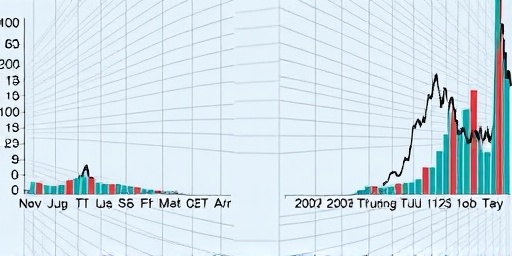In a resounding vote of confidence for the US economy, the latest Jobs report revealed that employers added a robust 250,000 positions in November, far surpassing economists’ forecasts of around 180,000. This surge propelled the unemployment rate down to a near-record low of 3.8%, marking the lowest level since early 2020 and signaling sustained strength in the labor market despite ongoing inflationary pressures. The data, released by the Bureau of Labor Statistics on Friday, comes at a pivotal moment as policymakers grapple with balancing growth and price stability.
The report not only exceeded expectations but also highlighted accelerating wage growth, with average hourly earnings rising 0.4% month-over-month and 4.1% year-over-year—outpacing inflation for the first time in months. This combination of job creation, low unemployment, and moderating wage pressures is fueling optimism for a ‘soft landing,’ where the economy cools without tipping into recession. Investors reacted positively, with stock futures climbing in after-hours trading, while the dollar strengthened against major currencies.
November’s performance underscores the resilience of the US labor market, which has added over 2.5 million jobs so far this year. Key sectors driving the gains included healthcare, leisure and hospitality, and professional services, reflecting a broad-based recovery that continues to defy earlier recession fears. However, beneath the surface, nuances like declining labor force participation and persistent hiring challenges in tech could temper the exuberance.
Healthcare and Hospitality Lead November’s Job Surge
The November Jobs report painted a vivid picture of sectoral strength, with healthcare providers adding a staggering 52,000 jobs, continuing a trend of consistent growth amid an aging population and pent-up demand for medical services. Hospitals and outpatient care centers were at the forefront, hiring nurses, physicians, and support staff to meet rising needs. This sector alone accounted for over 20% of the total job gains, underscoring its role as a bulwark in the labor market.
Leisure and hospitality followed closely, tacking on 43,000 positions as the holiday season kicked into gear. Restaurants, bars, and hotels ramped up staffing to handle increased consumer spending, with full-service eateries seeing particularly robust hiring. The sector, still recovering from pandemic-era disruptions, now employs nearly as many workers as pre-COVID levels, a testament to the economy’s adaptability. Transportation and warehousing contributed another 28,000 jobs, driven by e-commerce demand and logistics expansions from companies like Amazon and UPS.
Meanwhile, professional and business services added 37,000 roles, including temporary help and administrative positions, as firms outsourced more functions to manage costs. Retail trade saw a modest uptick of 18,000 jobs, boosted by seasonal hiring for Black Friday and Cyber Monday sales. However, manufacturing dipped slightly by 5,000, hampered by supply chain issues and higher interest rates cooling investment. Overall, these gains highlight a diversified labor market, less reliant on any single industry, which experts say bodes well for sustained unemployment levels.
To illustrate the breadth, consider the following breakdown from the Bureau of Labor Statistics:
- Healthcare: +52,000
- Leisure and Hospitality: +43,000
- Professional Services: +37,000
- Transportation: +28,000
- Retail: +18,000
- Manufacturing: -5,000
This distribution suggests the economy is not overheating in isolated pockets but growing steadily across the board, a key factor in maintaining the current low unemployment rate.
Wage Growth Accelerates, Easing Inflation Fears
A standout feature of the November Jobs report was the uptick in wage growth, which clocked in at 4.1% annually—the highest since June. For the average worker, this translates to real wage increases after adjusting for the 3.2% inflation rate reported earlier in the week. Low-wage earners saw even stronger gains, with minimum wage hikes in several states contributing to a narrowing income gap. This development is particularly welcome news for the labor market, where tight conditions have pressured employers to offer competitive pay to attract and retain talent.
Economists attribute the acceleration to persistent worker shortages in service-oriented fields. ‘Wage growth is finally catching up to productivity in a way that supports consumer spending without fueling runaway inflation,’ said Dr. Elena Ramirez, chief economist at the Economic Policy Institute. Her comments echo a broader sentiment that the current trajectory could allow the Federal Reserve to pause rate hikes sooner than anticipated.
Yet, not all is rosy. In high-skill sectors like information technology, wage stagnation persists due to layoffs at firms such as Meta and Google, which cut over 10,000 jobs combined earlier this year. The report also noted that average workweek hours edged up to 34.4, indicating employers are squeezing more output from existing staff rather than expanding headcounts aggressively. For context, wage growth has averaged 3.8% over the past year, but November’s figure signals a potential shift toward higher compensation amid the robust economy.
Looking at historical trends, the current unemployment and wage growth combo harkens back to the late 1990s boom, when similar conditions preceded a period of sustained expansion. If this pattern holds, it could mean brighter prospects for household finances, with disposable income rising and boosting sectors like housing and automobiles.
Economists and Policymakers Praise Labor Market Resilience
The surprise strength in the November jobs report has elicited a chorus of approval from economists and Fed officials, who see it as validation of the US economy’s underlying vigor. ‘This data reinforces that the labor market is cooling gradually without breaking, exactly what we’ve been aiming for,’ Federal Reserve Chair Jerome Powell stated in a recent interview, hinting at flexibility in monetary policy. Powell’s remarks, delivered just days before the report, now appear prescient as unemployment holds steady near historic lows.
Wall Street analysts were quick to revise their outlooks. Goldman Sachs raised its 2024 GDP forecast to 2.1% from 1.8%, citing the jobs report as a key driver. ‘The labor market’s performance suggests recession risks are fading, with unemployment unlikely to breach 4% anytime soon,’ noted lead economist Sarah Chen in a client note. However, some caution remains: the New York Fed’s recession probability model still pegs odds at 15% over the next 12 months, factoring in global uncertainties like geopolitical tensions.
From a policy perspective, the report bolsters arguments against aggressive rate cuts. With wage growth outpacing inflation, the Fed may hold steady at its December meeting, opting for a 25-basis-point hike instead of pausing. Labor Secretary Marty Walsh praised the figures during a press briefing, emphasizing initiatives like the CHIPS Act that are creating high-quality jobs in semiconductors and clean energy. ‘We’re building an economy that works for everyone, not just the top earners,’ Walsh said, highlighting how the low unemployment rate is benefiting minority and female workers disproportionately.
Interviews with business leaders reveal mixed sentiments. A survey by the National Association of Manufacturers found 72% of executives planning to hire in Q1 2024, up from 65% last quarter, but citing rising costs as a hurdle. This blend of optimism and pragmatism captures the nuanced state of the economy post-jobs report.
Federal Reserve Eyes Soft Landing as Job Data Shapes Rate Path
As the dust settles on the November jobs report, attention turns to its implications for the Federal Reserve’s path forward. The combination of 250,000 new jobs, a 3.8% unemployment rate, and accelerating wage growth positions the central bank for a delicate balancing act. Markets now price in a 70% chance of a rate pause by March 2024, up from 50% pre-report, according to CME FedWatch Tool data. This shift reflects growing confidence that the labor market can absorb higher borrowing costs without derailing growth.
Looking ahead, December’s consumer price index and upcoming jobs data will be scrutinized for signs of sustained momentum. If unemployment remains below 4% and wage growth moderates to 3.5-4%, analysts predict the Fed could begin easing as early as mid-2024, potentially lowering the federal funds rate to 4.5% by year-end. Such a scenario would alleviate pressure on mortgages and credit cards, stimulating investment in real estate and small businesses.
For workers, the report’s silver lining is enhanced job security and bargaining power. With labor market tightness persisting, union negotiations in auto and rail industries are gaining leverage, potentially leading to broader wage standards. Businesses, meanwhile, face the challenge of talent acquisition; platforms like LinkedIn report a 25% increase in job postings for skilled trades, underscoring the need for upskilling programs.
On the horizon, external factors like potential government shutdowns or trade disputes could test this resilience. Yet, the November figures suggest the US economy is well-equipped to navigate turbulence, with a healthy labor market serving as its anchor. As 2023 draws to a close, these developments point to a year of continued expansion, where low unemployment and steady wage growth underpin a brighter outlook for American households and enterprises alike.









